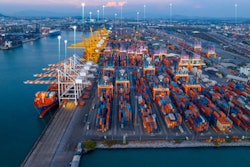The freight market remains stagnant, mired in tariff policies and other economic factors, according to analysts.
Freight activity in May followed typical seasonal trends, but overall, the freight market “remains in a holding pattern,” David Spencer, vice president of market intelligence at Arrive Logistics wrote in the company’s June Market Update report.
Spencer said patterns from previous months remain: low freight volume, a surplus of available capacity, and spot rates that spike briefly but stabilize quickly.
Since the Trump administration’s announcement of new tariffs on April 2, the average tariff rose to 28%, according to Uber Freight’s Q2 market update and outlook report. Trade deals and temporary suspensions of some tariffs helped reduce the average duty to 18%. If importers find alternatives other than China, it could drop further, possibly to a range between 10% and 18%.
However, a 1% increase in the average tariff rate could decrease truckload demand by -.15% to -.25%, Uber Freight said in its report. A rate of 18% to 28% could dampen demand by 4% to 6%.
Higher rates can drive up prices and may cause consumers to buy less, leading to fewer goods for trucks to haul. This can be seen with recent Descartes data in May, indicating that imports fell 9.7% month-over-month and 7.2% year-over-year. Imports from China dropped more sharply, down -20.8% month-over-month – the steepest decline since March 2020 – and 28.5% year-over-year.
Port activity also shifted in May, with East and Gulf Coast ports capturing a larger share of cargo traffic, Descartes noted. West Coast ports saw declines, largely due to a sharp drop in shipments from China.
After months of import growth and wave of front-loading shipments in April, the impact of tariffs has begun to materialize in May, along with the impact of U.S. policy shifts with China, said Jackson Wood, director of industry strategy at Descartes.
The Port of Los Angeles reported that May saw volume decline 5% year-over-year and dip 19% compared to April, citing the impact of tariffs on both imports and exports.
Looking ahead
While there isn’t any foreseeable near-term demand disruption to trigger sustained inflationary rate pressure, Spencer pointed out a few factors that could influence market conditions through the season.
A key uncertainty is the pending court decision on the legality on U.S. tariffs, which could reshape the ongoing U.S.-China trade dynamic.
“That said, the recent reduction of some tariffs has temporarily eased pressure, and forward-looking import data on orders placed but not yet shipped suggests a volume recovery may be on the horizon,” said Spencer.
Economic headwinds loom, however, as rising prices are cooling consumer spending that could dampen future demand, he added.
“Resilient carriers are supporting supply levels amid ongoing volume declines, limiting upward rate pressure even as spot activity briefly increased last month,” he said. “If sluggish demand and elevated capacity levels persist, it could limit any upside market potential in the coming months.”
The onset of the new English proficiency requirements from the Federal Motor Carrier Safety Administration may also reduce capacity, Spencer added, though the timing and scale of the impact remains unclear.













